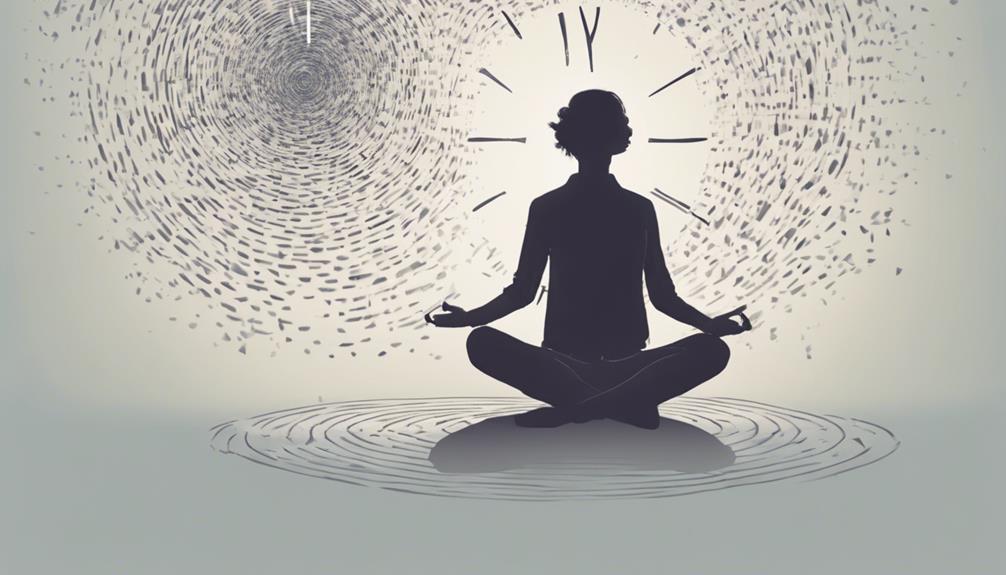Master the art of self-hypnosis with beginner-friendly tips for personal growth. Create a serene space by adjusting lighting, noise levels, and minimizing distractions. Use powerful suggestion techniques with precise language and positive affirmations. Customize scripts and practice relaxation techniques like deep breathing and muscle relaxation. Visualize desired outcomes and repeat sessions regularly for effectiveness. Explore the potential of your subconscious mind for habits, beliefs, and emotional healing. Improve focus, reduce stress, and enhance overall well-being. Unleash the benefits of self-hypnosis through goal setting, motivation, and creativity. Dive deeper into self-hypnosis for health, wellness, and a fulfilling life.
Benefits of Self-Hypnosis for Beginners

For beginners, exploring the benefits of self-hypnosis can offer a valuable gateway into the realm of personal empowerment and self-improvement. Self-hypnosis is a powerful tool that can aid individuals in self-discovery and mindfulness.
By engaging in self-hypnosis practices, individuals can delve deeper into their subconscious mind, uncovering hidden beliefs and patterns that may be hindering personal growth. This heightened self-awareness can lead to a greater sense of empowerment as individuals gain control over their thoughts and behaviors.
Moreover, self-hypnosis can foster personal growth by helping individuals tap into their inner strengths and resources. Through regular practice, individuals can develop a stronger connection with their subconscious mind, enabling them to set and achieve meaningful goals. This process of self-improvement can lead to increased confidence, resilience, and overall well-being.
Setting the Right Environment
Creating an optimal environment is key to maximizing the effectiveness of self-hypnosis techniques. When setting up for a self-hypnosis session, consider the lighting choices in the room. Soft, dim lighting can help induce a sense of relaxation and focus, aiding in the hypnotic process.
Additionally, controlling noise levels is crucial. Ensure the space is quiet or use calming background music to drown out any disruptive sounds.
Comfortable seating is essential to prevent physical distractions during self-hypnosis. Choose a chair or cushion that supports good posture and allows for relaxation without the risk of discomfort.
Furthermore, minimize distractions in the environment. Keep the space tidy and free from clutter to promote mental clarity and focus. This includes turning off electronic devices and silencing notifications that could interrupt the hypnotic state.
Understanding the Power of Suggestion

How does suggestion play a crucial role in the effectiveness of self-hypnosis techniques?
Suggestion techniques are fundamental to self-hypnosis as they directly influence the subconscious power of the mind. Through the use of hypnotic language and positive affirmations, individuals can plant specific ideas or beliefs into their subconscious, leading to desired behavioral changes or outcomes.
When employing suggestion techniques during self-hypnosis, it is essential to use precise and affirmative language to communicate with the subconscious mind effectively. Positive affirmations, such as 'I am confident and capable,' 'I choose to be calm and relaxed,' or 'I am worthy of success,' can help reprogram the subconscious mind towards more empowering beliefs and behaviors.
The power of suggestion lies in its ability to bypass the critical faculty of the conscious mind and directly influence the deeper levels of consciousness. By consistently incorporating well-crafted suggestions into self-hypnosis sessions, individuals can harness the subconscious power to facilitate personal growth, overcome challenges, and achieve their desired goals.
Choosing Effective Self-Hypnosis Scripts
What criteria should one consider when selecting self-hypnosis scripts for optimal effectiveness?
When choosing self-hypnosis scripts, individuals should assess script variations to find content that resonates with their specific goals and preferences. Customizing content to address personal needs enhances the relevance and impact of the script.
Moreover, considering whether to engage in guided sessions or solo practice is crucial. Guided sessions can provide structure, support, and expertise, making them beneficial for beginners or individuals seeking external guidance. On the other hand, solo practice allows for independence and customization, enabling individuals to tailor the experience to suit their unique requirements.
Evaluating these factors can help individuals select self-hypnosis scripts that align with their objectives and learning style, ultimately enhancing the effectiveness of their self-hypnosis practice. By carefully considering script variations, customizing content, and choosing between guided sessions and solo practice, individuals can optimize their self-hypnosis experience for maximum benefit.
Relaxation Techniques for Successful Hypnosis

To facilitate successful hypnosis, mastering relaxation techniques is fundamental as it sets the groundwork for accessing the subconscious mind effectively. Deep breathing is a cornerstone of relaxation and can help induce a state of calmness conducive to hypnosis. By focusing on slow, deep breaths, practitioners can lower their heart rate and promote relaxation, making it easier to enter a hypnotic state.
Progressive relaxation is another valuable technique for achieving deep relaxation. This method involves systematically tensing and then relaxing different muscle groups in the body, releasing physical tension and promoting a sense of overall relaxation. This process can help individuals become more attuned to their bodies and more receptive to hypnotic suggestions.
Incorporating both deep breathing and progressive relaxation into your self-hypnosis practice can significantly enhance your ability to enter a hypnotic state and access your subconscious mind more effectively.
Visualizations and Affirmations for Focus
Utilizing visualizations and affirmations can enhance focus during self-hypnosis sessions by engaging the mind's capacity for imagery and positive reinforcement.
Mental imagery plays a crucial role in self-hypnosis as it allows individuals to create vivid internal pictures that can influence their thoughts, feelings, and behaviors. By incorporating detailed mental images during self-hypnosis, individuals can immerse themselves more deeply in the hypnotic experience, fostering a heightened sense of focus and receptivity to positive suggestions.
Positive statements, or affirmations, are another essential component of enhancing focus during self-hypnosis. Affirmations are short, powerful statements that are repeated to oneself to instill a particular belief or intention.
When used in conjunction with visualizations, affirmations can further reinforce the desired outcome of the hypnosis session. By consistently integrating positive statements into the hypnotic practice, individuals can reprogram their subconscious mind, promoting focus, confidence, and overall success in achieving their goals.
Practice and Patience in Self-Hypnosis

In mastering self-hypnosis techniques, developing a consistent practice and cultivating patience are fundamental aspects that contribute to long-term success in harnessing the power of the mind.
Consistent practice involves setting aside dedicated time each day to engage in self-hypnosis sessions. By adhering to a regular schedule, individuals can train their minds to enter a hypnotic state more efficiently over time. This practice helps in strengthening mental focus, allowing individuals to immerse themselves more deeply in the hypnotic experience.
Patience is equally crucial in the practice of self-hypnosis. It is important to understand that mastering self-hypnosis is a gradual process that requires time and persistence. Individuals may not experience immediate results, but with patience, they can gradually improve their ability to enter a hypnotic state, deepen their focus, and achieve their desired outcomes.
Developing patience also involves accepting any initial challenges or setbacks with a positive mindset, knowing that progress will come with continued practice and dedication. By combining consistent practice with patience, individuals can enhance their self-hypnosis skills and unlock the full potential of their subconscious mind.
Frequently Asked Questions
Can Self-Hypnosis Be Used to Treat Specific Medical Conditions?
Self-hypnosis has shown promise in pain management and anxiety relief for specific medical conditions. Research suggests its potential benefits, such as reducing discomfort and promoting relaxation. However, it's crucial to consult healthcare professionals for comprehensive treatment plans.
Is It Possible to Self-Hypnotize Without Prior Experience?
Self-hypnosis effectiveness varies based on individual receptiveness and commitment. While prior experience can facilitate the learning curve, it's possible to self-hypnotize without it through guided resources and practice, gradually enhancing proficiency and results.
How Long Should a Self-Hypnosis Session Ideally Last?
The optimal duration for a self-hypnosis session depends on individual needs and goals. Generally, effective techniques suggest sessions lasting between 20 to 30 minutes to allow for deep relaxation and subconscious engagement without overwhelming the mind.
Are There Any Risks or Side Effects Associated With Self-Hypnosis?
Potential dangers and misconceptions surrounding self-hypnosis include the risk of creating false memories or experiencing distressing emotions. However, with proper safety precautions and guidance, self-hypnosis can offer numerous benefits such as stress reduction and improved focus.
Can Self-Hypnosis Help With Improving Self-Confidence and Motivation?
Self-hypnosis can be a beneficial tool for improving self-confidence and motivation by fostering personal growth and empowerment. It can enhance mental wellness and positivity, enabling individuals to tap into their inner strengths and achieve positive changes.
Conclusion
In conclusion, beginner-friendly self-hypnosis techniques can provide numerous benefits, such as stress reduction, improved focus, and personal growth.
By creating a conducive environment, understanding the power of suggestion, selecting appropriate scripts, practicing relaxation techniques, and utilizing visualizations and affirmations, individuals can effectively engage in self-hypnosis.
With dedication, patience, and consistent practice, beginners can harness the power of self-hypnosis to achieve their desired goals and enhance their overall well-being.
